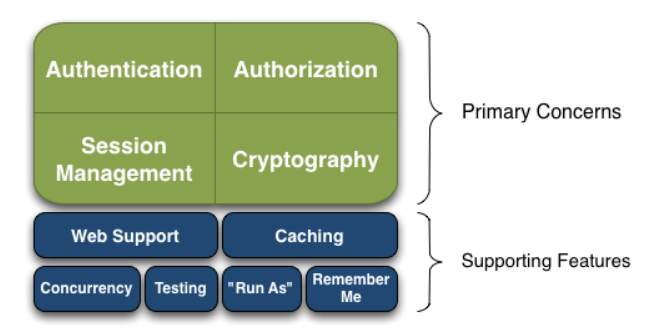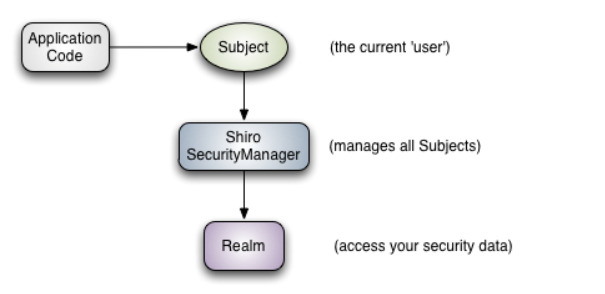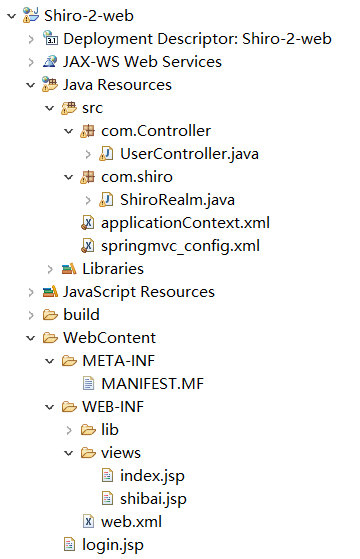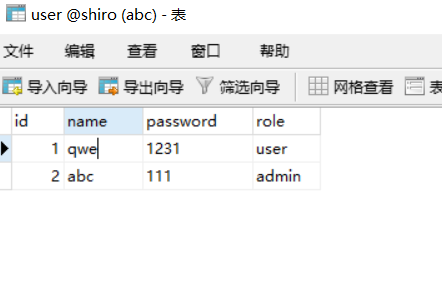Shiro基础
Shiro是一个强大的简单易用的Java安全框架,主要用来更便捷的认证,授权,加密,会话管理。
1.简介:
Shiro 可以帮助我们完成:认证、授权、加密、会话管理、与 Web 集成、缓存等。
其基本功能点:

- Authentication:身份认证 / 登录,验证用户是不是拥有相应的身份;
- Authorization:授权,即权限验证,验证某个已认证的用户是否拥有某个权限;即判断用户是否能做事情,常见的如:验证某个用户是否拥有某个角色。或者细粒度的验证某个用户对某个资源是否具有某个权限;
- Session Manager:会话管理,即用户登录后就是一次会话,在没有退出之前,它的所有信息都在会话中;会话可以是普通 JavaSE 环境的,也可以是如 Web 环境的;
- Cryptography:加密,保护数据的安全性,如密码加密存储到数据库,而不是明文存储;
- Web Support:Web 支持,可以非常容易的集成到 Web 环境;
- Caching:缓存,比如用户登录后,其用户信息、拥有的角色 / 权限不必每次去查,这样可以提高效率;
- Concurrency:shiro 支持多线程应用的并发验证,即如在一个线程中开启另一个线程,能把权限自动传播过去;
- Testing:提供测试支持;
- Run As:允许一个用户假装为另一个用户(如果他们允许)的身份进行访问;
- Remember Me:记住我,这个是非常常见的功能,即一次登录后,下次再来的话不用登录了。
Shiro的工作原理:

- Subject:主体,代表了当前 “用户”,这个用户不一定是一个具体的人,与当前应用交互的任何东西都是 Subject,如网络爬虫,机器人等;所有 Subject 都绑定到 SecurityManager,与 Subject 的所有交互都会委托给 SecurityManager;可以把 Subject 认为是一个门面;SecurityManager 才是实际的执行者;
- SecurityManager:安全管理器;即所有与安全有关的操作都会与 SecurityManager 交互;且它管理着所有 Subject;可以看出它是 Shiro 的核心,它负责与后边介绍的其他组件进行交互,如果学习过 SpringMVC,你可以把它看成 DispatcherServlet 前端控制器;
- Realm:域,Shiro 从 Realm 中获取安全数据(如用户User、角色Role、权限),就是说 SecurityManager 要验证用户身份,那么它需要从 Realm 中获取相应的用户信息进行比较以确定用户身份是否合法;也需要从 Realm 得到用户相应的角色 / 权限进行验证用户是否能进行权限操作;可以把 Realm 看成 DataSource,即安全数据源。
总结:
应用代码通过 Subject 来进行认证和授权,而 Subject 又委托给 SecurityManager;
我们需要给 Shiro 的 SecurityManager 注入 Realm,从而让 SecurityManager 能得到合法的用户及其权限进行判断。
Shiro 不提供维护用户 / 权限,而是通过 Realm 让开发人员自己注入。
2.java SE 环境下的Shiro 使用:
1. 准备环境依赖:
添加 junit、common-logging 及 shiro-core 依赖即可。
这里使用的是Gradle管理工具。
build.gradle:
dependencies {
// This dependency is exported to consumers, that is to say found on their compile classpath.
api 'org.apache.commons:commons-math3:3.6.1'
// This dependency is used internally, and not exposed to consumers on their own compile classpath.
implementation 'com.google.guava:guava:23.0'
// Use JUnit test framework
testImplementation 'junit:junit:4.12'
// https://mvnrepository.com/artifact/org.apache.shiro/shiro-core
compile group: 'org.apache.shiro', name: 'shiro-core', version: '1.4.0'
// https://mvnrepository.com/artifact/commons-logging/commons-logging
compile group: 'commons-logging', name: 'commons-logging', version: '1.2'
// https://mvnrepository.com/artifact/org.slf4j/slf4j-log4j12
testCompile group: 'org.slf4j', name: 'slf4j-log4j12', version: '1.7.21'
}2.测试登录验证:
- 编写shiro.ini配置文件:
shiro.ini
[users]
# ---root为用户名,密码是 secret ,拥有admin角色----
root=secret,admin
guest = guest, guest
presidentskroob = 12345, president
darkhelmet = ludicrousspeed, darklord, schwartz
aihe=aihe,client
# -----aihe用户密码为aihe ,拥有goodguy,client角色---------------------------
[roles]
# ------admin 拥有 *代表所有的权限, -----------------------------------------------------------------------
admin = *
client = look:*
goodguy = winnebago:drive:eagle5- 编写代码:
public class test_shiro {
private static final transient Logger log = LoggerFactory.getLogger(test_shiro.class);
public static void main(String[] args) {
log.info("My First Apache Shiro Application");
//1.解析ini文件, 获取SecurityManager工厂,此处使用Ini配置文件初始化SecurityManager
Factory<SecurityManager> factory = new IniSecurityManagerFactory(
"classpath:shiro.ini");
//2.得到SecurityManager实例 并绑定给SecurityUtils
SecurityManager securityManager = factory.getInstance();
SecurityUtils.setSecurityManager(securityManager);
//3、通过SecurityUtils 得到Subject(当前用户)
Subject user = SecurityUtils.getSubject();
if(user.isAuthenticated()==false) { //用户是否登录过
//4.创建用户名/密码身份验证Token令牌,并记住令牌
UsernamePasswordToken token = new UsernamePasswordToken("darkhelmet", "ludicrousspeed"); //darkhelmet 为用户名,ludicrousspeed为密码
token.setRememberMe(true);
try {
//4、当前用户通过令牌进行登录
user.login(token);
System.out.println("身份验证success");
} catch(UnknownAccountException e) {
System.out.println("用户名错误 ");
} catch(IncorrectCredentialsException e ) {
System.out.println("密码错误");
} catch(AuthenticationException e) {
System.out.println("验证错误");
}
}
// 查看用户是否有指定的角色,由于在shiro.ini配置文件中 root 没有client角色,aihe有该角色
if ( user.hasRole( "client" ) ) {
System.out.println("有指定的角色权限");
} else {
System.out.println("没有指定的角色权限");
}
//判断当前用户是否拥有指定的权限
if(user.isPermitted("winnebago:drive:eagle5")) {
System.out.println("当前用户拥有指定的权限");
}else {
System.out.println("当前用户bu拥有指定的权限");
}
user.logout(); //退出登录
}
}总结:
- 指定一个 ini 配置文件来创建一个 SecurityManager 工厂;
- 获取 SecurityManager 并绑定到 SecurityUtils,这是一个全局设置,设置一次即可;
- 通过 SecurityUtils 得到 Subject,其会自动绑定到当前线程;如果在 web 环境在请求结束时需要解除绑定;然后获取身份验证的 Token,如用户名 / 密码;
- 调 用 subject.login 方法进行登录,其会自动委托给 SecurityManager.login 方法进行登录;
- 如果身份验证失败请捕获 AuthenticationException 或其子类等,
- 调用 subject.logout 退出,其会自动委托给 SecurityManager.logout 方法退出。
3.WEB环境下的Shiro使用:

1.准备环境依赖:
- spring的所有jar包
- java与mysql的驱动包 :mysql-connector-java-5.1.42-bin.jar
- shiro需要的所有jar包 shiro-all-1.3.2.jar , slf4j-api-1.7.25.jar ,slf4j-log4j12-1.7.25.jar , log4j-1.2.17.jar
2. spring+springmvc+jdbc+shiro的环境搭建:
- 创建动态web工程。
- 导入jar包。
- 编写配置文件:
applicationContext.xml: spring的配置文件中需要配置shiro的相关bean
<?xml version="1.0" encoding="UTF-8"?>
<beans xmlns="http://www.springframework.org/schema/beans"
xmlns:p="http://www.springframework.org/schema/p"
xmlns:mybatis="http://mybatis.org/schema/mybatis-spring"
xmlns:xsi="http://www.w3.org/2001/XMLSchema-instance" xmlns:mvc="http://www.springframework.org/schema/mvc"
xmlns:aop="http://www.springframework.org/schema/aop"
xmlns:context="http://www.springframework.org/schema/context" xmlns:tx="http://www.springframework.org/schema/tx"
xsi:schemaLocation="http://www.springframework.org/schema/mvc http://www.springframework.org/schema/mvc/spring-mvc-4.3.xsd
http://www.springframework.org/schema/beans http://www.springframework.org/schema/beans/spring-beans.xsd
http://www.springframework.org/schema/tx http://www.springframework.org/schema/tx/spring-tx-4.3.xsd
http://www.springframework.org/schema/context http://www.springframework.org/schema/context/spring-context-4.3.xsd
http://mybatis.org/schema/mybatis-spring
http://mybatis.org/schema/mybatis-spring.xsd
http://www.springframework.org/schema/aop
http://www.springframework.org/schema/aop/spring-aop-4.3.xsd">
<!-- id 值 必须与web.xml 中配置的 shiroFilter 这个过滤器的Filter-name 保持一致,因为过滤器的类是代理类-->
<bean id="shiroFilter" class="org.apache.shiro.spring.web.ShiroFilterFactoryBean">
<property name="securityManager" ref="securityManager" />
<property name="loginUrl" value="/login.jsp"/> <!-- 无需认证可进入的页面 -->
<!-- 代表过滤器的详细配置 -->
<property name="filterChainDefinitions">
<value>
<!-- anon 表示不需要验证,authc 表示需要认证。
这里意思是除了访问login.jsp页面,/login请求,/Shiro_login请求,不需要认证登录,
其他都需要认证登录,否则会一直在login页面
-->
/login.jsp = anon
/login = anon
/Shiro_login = anon
/** = authc
</value>
</property>
</bean>
<!-- 需要注入该bean,应为shiro底层需要使用该类 -->
<bean id="securityManager" class="org.apache.shiro.web.mgt.DefaultWebSecurityManager">
<property name="realm" ref="myRealm"/>
</bean>
<!-- 手动创建ShiroRealm 这个bean ,该bean被securityManager 引用-->
<bean id="myRealm" class="com.shiro.ShiroRealm"/>
<!-- 必须有,用来管理spring容器中常用的对象 -->
<bean id="lifecycleBeanPostProcessor" class="org.apache.shiro.spring.LifecycleBeanPostProcessor"/>
<!-- 开启shiro注解 -->
<bean class="org.springframework.aop.framework.autoproxy.DefaultAdvisorAutoProxyCreator" depends-on="lifecycleBeanPostProcessor"/>
<bean class="org.apache.shiro.spring.security.interceptor.AuthorizationAttributeSourceAdvisor">
<property name="securityManager" ref="securityManager"/>
</bean>
</beans>springmvc_config.xml: springmvc的配置文件中需要指明Controller类的位置,从而通过扫描注解注入到容器中,视图解析器等。
<?xml version="1.0" encoding="UTF-8"?>
<beans
xmlns="http://www.springframework.org/schema/beans"
xmlns:xsi="http://www.w3.org/2001/XMLSchema-instance"
xmlns:tx="http://www.springframework.org/schema/tx"
xmlns:context="http://www.springframework.org/schema/context"
xmlns:mvc="http://www.springframework.org/schema/mvc"
xsi:schemaLocation="http://www.springframework.org/schema/beans
http://www.springframework.org/schema/beans/spring-beans-3.2.xsd
http://www.springframework.org/schema/tx
http://www.springframework.org/schema/tx/spring-tx-3.2.xsd
http://www.springframework.org/schema/context
http://www.springframework.org/schema/context/spring-context-3.2.xsd
http://www.springframework.org/schema/mvc
http://www.springframework.org/schema/mvc/spring-mvc-3.2.xsd">
<!-- 自动扫描的包名 , 若扫描到spring注解的类,这些类被注入到ioc容器中 -->
<context:component-scan base-package="com.Controller"/>
<mvc:annotation-driven />
<!-- 视图解析器, 把控制器的方法 返回的值通过 prefix + 返回值 + suffix 的形式,得到响应的jsp页面 -->
<bean class="org.springframework.web.servlet.view.InternalResourceViewResolver">
<property name="prefix" value="/WEB-INF/views/"/>
<property name="suffix" value=".jsp"/>
</bean>
</beans>web.xml: 该配置中给出springmvc,spring的配置文件的位置,并进行shiro的配置。
<?xml version="1.0" encoding="UTF-8"?>
<web-app xmlns:xsi="http://www.w3.org/2001/XMLSchema-instance" xmlns="http://xmlns.jcp.org/xml/ns/javaee" xsi:schemaLocation="http://xmlns.jcp.org/xml/ns/javaee http://xmlns.jcp.org/xml/ns/javaee/web-app_3_1.xsd" id="WebApp_ID" version="3.1">
<display-name>Shiro-2-web</display-name>
<!-- 配置DispatcherServlet -->
<servlet>
<servlet-name>springmvc</servlet-name>
<servlet-class>org.springframework.web.servlet.DispatcherServlet</servlet-class>
<init-param>
<param-name>contextConfigLocation</param-name>
<param-value>classpath:springmvc_config.xml</param-value>
</init-param>
<load-on-startup>1</load-on-startup>
</servlet>
<servlet-mapping>
<servlet-name>springmvc</servlet-name>
<url-pattern>/</url-pattern>
</servlet-mapping>
<!--监听 spring的ioc容器-->
<listener>
<listener-class>org.springframework.web.context.ContextLoaderListener</listener-class>
</listener>
<context-param>
<param-name>contextConfigLocation</param-name>
<param-value>classpath:applicationContext.xml</param-value>
</context-param>
<!--
shiro 配置开始:
spring 与 shiro 的集成
DelegatingFilterProxy作用是自动到spring容器查找名字为shiroFilter(filter-name)的bean并把所有Filter的操作委托给它,类似门卫的作用。
然后将ShiroFilter配置到spring容器即可:
-->
<filter>
<filter-name>shiroFilter</filter-name>
<filter-class>org.springframework.web.filter.DelegatingFilterProxy</filter-class>
<async-supported>true</async-supported>
<init-param>
<param-name>targetFilterLifecycle</param-name>
<param-value>true</param-value>
</init-param>
<!-- targetBeanName 属性 指定 查找的bean的名字,并把过滤器的操作委托给该bean,如果不写则默认为filter-name标签的值 -->
<init-param>
<param-name>targetBeanName</param-name>
<param-value>shiroFilter</param-value>
</init-param>
</filter>
<filter-mapping>
<filter-name>shiroFilter</filter-name>
<url-pattern>/*</url-pattern>
</filter-mapping>
<!-- shiro配置 结束 -->
</web-app>- 编写身份验证的代码:
①:login.jsp:
<body>
Shiro-login:
<form action="Shiro_login" method="post">
username:<input type="text" name="username"/>
password:<input type="text" name="password"/>
<input type="submit" value="tijiao"/>
</form>
</body>②:UserController.java:
@Controller
public class UserController {
@RequestMapping(value = "/Shiro_login")
public String Shiro_login(@RequestParam(value = "username") String username,
@RequestParam(value = "password") String password) {
/*
* 0.创建SecurityManager工厂,得到SecurityManager实例 并绑定给SecurityUtils
* 已经在配置文件中完成。
* 1. 通过SecurityUtils 得到Subject(当前用户)
* 2. 判断用户是否登录
* 3. 通过传过来的用户名与密码,创建认证令牌
* 4. 通过令牌进行登录验证
* */
Subject currentUser = SecurityUtils.getSubject();
if(currentUser.isAuthenticated()==false) { //用户是否登录过
//.创建用户名/密码身份验证Token令牌,并记住令牌
UsernamePasswordToken token = new UsernamePasswordToken(username,password);
token.setRememberMe(true);
try {
/*当前用户通过令牌进行登录
*
* 调用login(token); 方法 在底层中会调用对应realm的bean类的doGetAuthenticationInfo方法
* 并把token 当作参数传给这个方法,在这个方法中实现与数据库信息的验证。
* 在login方法中 如果验证错误会抛出异常,通过抛出异常的方式,来表达验证错误,
* 验证正确会正常执行下一行代码,没有返回值。
* */
currentUser.login(token);
System.out.println("身份验证success");
} catch(AuthenticationException e) {
System.out.println("验证错误");
return "shibai";
}
}
return "index";
}
}③:ShiroRealm.class:
//在ShiroRealm类中需要查询数据库来进行认证
public class ShiroRealm extends AuthenticatingRealm {
/*
* 1. doGetAuthenticationInfo : 获取数据库数据,进行验证,若数据库没有对于数据,返回null ,若有,返回AuthenticationInfo 对象
* 2. AuthenticationInfo :该对象可以使用SimpleAuthenticationInfo类(AuthenticationInfo类的子类) 封装正确的用户名与密码
* 3. token :里面封装了需要验证的用户名密码
* */
@Override
protected AuthenticationInfo doGetAuthenticationInfo(AuthenticationToken token) throws AuthenticationException {
System.out.println(" this is ShiroRealm ");
SimpleAuthenticationInfo info=null;
//1.把token 装换为UsernamePasswordToken类对象
UsernamePasswordToken userToken=(UsernamePasswordToken) token;
//2.获取令牌中用户名:
String username = userToken.getUsername();
//3.链接数据库:
Connection conn=null;
try {
Class.forName("com.mysql.jdbc.Driver");
conn=DriverManager.getConnection("jdbc:mysql://localhost:3306/Shiro","root","root");
} catch (ClassNotFoundException e) {
System.out.println("数据库链接失败1");
} catch (SQLException e) {
System.out.println("数据库链接失败2");
}
//4.通过用户名查询数据库:
try {
String sql="select * from user where name=?";
PreparedStatement pstmt = conn.prepareStatement(sql);
pstmt.setString(1, username);
ResultSet rs = pstmt.executeQuery();
if(rs.next()) {
/*
* info= new SimpleAuthenticationInfo(username, rs.getString(3), this.getName());
*
* username : 传入的token中的用户名(用户输入的用户名),也可以传对象。
* rs.getString(3) : 数据库中获取的密码。
* this.getName() : 这里的this 是指的ShiroRealm类,所以是获取的类名。
*
* 传入的password(这里是从数据库获取的)和token(filter中登录时生成的)中的password做对比,
* 如果相同就允许登录,不相同就抛出异常。
*
* */
info=new SimpleAuthenticationInfo(username, rs.getString(3), this.getName());
}else {
System.out.println("查询数据不存在异常");
throw new AuthenticationException();
}
} catch (SQLException e) {
System.out.println("查询异常");
}
return info;
}
}4.多Realm数据验证两种配置:
1.第一种:
- 创建多个Realm类。
- spring的配置文件完成多个Realm类的注入。
- 在spring的配置文件中对securityManager类中属性设置为多个Realm类。
①:创建多个不同的Realm实例,它们可以使用不同的数据库或加密方式来验证用户输入的数据。
ShiroRealm.java:
查询的是 shiro 数据库。
package com.shiro;
//在ShiroRealm类中需要查询数据库来进行认证
public class ShiroRealm extends AuthenticatingRealm {
@Override
protected AuthenticationInfo doGetAuthenticationInfo(AuthenticationToken token) throws AuthenticationException {
System.out.println(" this is ShiroRealm ");
SimpleAuthenticationInfo info=null;
UsernamePasswordToken userToken=(UsernamePasswordToken) token;
String username = userToken.getUsername();
Connection conn=null;
try {
Class.forName("com.mysql.jdbc.Driver");
conn=DriverManager.getConnection("jdbc:mysql://localhost:3306/Shiro","root","root");
} catch (ClassNotFoundException e) {
System.out.println("数据库链接失败1");
} catch (SQLException e) {
System.out.println("数据库链接失败2");
}
try {
String sql="select * from user where name=?";
PreparedStatement pstmt = conn.prepareStatement(sql);
pstmt.setString(1, username);
ResultSet rs = pstmt.executeQuery();
if(rs.next()) {
info=new SimpleAuthenticationInfo(username, rs.getString(3), this.getName());
}else {
System.out.println("查询数据不存在异常");
throw new AuthenticationException();
}
} catch (SQLException e) {
System.out.println("查询异常");
}
return info;
}
}ShiroRealm2.java: 查询的是 shiro2 数据库。
package com.shiro;
//在ShiroRealm类中需要查询数据库来进行认证
public class ShiroRealm2 extends AuthenticatingRealm {
@Override
protected AuthenticationInfo doGetAuthenticationInfo(AuthenticationToken token) throws AuthenticationException {
System.out.println(" this is ShiroRealm2 ");
SimpleAuthenticationInfo info=null;
UsernamePasswordToken userToken=(UsernamePasswordToken) token;
String username = userToken.getUsername();
Connection conn=null;
try {
Class.forName("com.mysql.jdbc.Driver");
conn=DriverManager.getConnection("jdbc:mysql://localhost:3306/Shiro2","root","root");
} catch (ClassNotFoundException e) {
System.out.println("数据库链接失败1");
} catch (SQLException e) {
System.out.println("数据库链接失败2");
}
try {
String sql="select * from user where name=?";
PreparedStatement pstmt = conn.prepareStatement(sql);
pstmt.setString(1, username);
ResultSet rs = pstmt.executeQuery();
if(rs.next()) {
info=new SimpleAuthenticationInfo(username, rs.getString(3), this.getName());
}else {
System.out.println("查询数据不存在异常");
throw new AuthenticationException();
}
} catch (SQLException e) {
System.out.println("查询异常");
}
return info;
}
}②:修改spring的配置文件:
applicationContext.xml: spring的配置文件中需要配置shiro的相关bean
<?xml version="1.0" encoding="UTF-8"?>
<beans xmlns="http://www.springframework.org/schema/beans"
xmlns:p="http://www.springframework.org/schema/p"
xmlns:mybatis="http://mybatis.org/schema/mybatis-spring"
xmlns:xsi="http://www.w3.org/2001/XMLSchema-instance" xmlns:mvc="http://www.springframework.org/schema/mvc"
xmlns:aop="http://www.springframework.org/schema/aop"
xmlns:context="http://www.springframework.org/schema/context" xmlns:tx="http://www.springframework.org/schema/tx"
xsi:schemaLocation="http://www.springframework.org/schema/mvc http://www.springframework.org/schema/mvc/spring-mvc-4.3.xsd
http://www.springframework.org/schema/beans http://www.springframework.org/schema/beans/spring-beans.xsd
http://www.springframework.org/schema/tx http://www.springframework.org/schema/tx/spring-tx-4.3.xsd
http://www.springframework.org/schema/context http://www.springframework.org/schema/context/spring-context-4.3.xsd
http://mybatis.org/schema/mybatis-spring
http://mybatis.org/schema/mybatis-spring.xsd
http://www.springframework.org/schema/aop
http://www.springframework.org/schema/aop/spring-aop-4.3.xsd">
<!--此处省略 。。。。。-->
<!-- 引用多个不同的Realm -->
<bean id="securityManager" class="org.apache.shiro.web.mgt.DefaultWebSecurityManager">
<property name="realms">
<list>
<ref bean="myRealm"/>
<ref bean="myRealm2"/>
</list>
</property>
</bean>
<!-- 多Realm bean实例,他们可以使用不同的数据库或加密方式-->
<bean id="myRealm" class="com.shiro.ShiroRealm"/>
<bean id="myRealm2" class="com.shiro.ShiroRealm2"/>
<!--此处省略 。。。。。-->
</beans>③:登录截图: 
2.第二种:
- 创建多个Realm类。
- spring的配置文件完成多个Realm类的注入。
- 在spring的ioc容器中配置自定义认证器,该自定义认证器需实现ModularRealmAuthenticator.
- 对自定义认证器的属性进行修改,使得该bean能够使用多Realm。
①与②的步骤与第一种方式相同 ③与④:修改ModularRealmAuthenticator这个bean,可以把该bean作为自定义认证器
<?xml version="1.0" encoding="UTF-8"?>
<beans xmlns="http://www.springframework.org/schema/beans"
xmlns:p="http://www.springframework.org/schema/p"
xmlns:mybatis="http://mybatis.org/schema/mybatis-spring"
xmlns:xsi="http://www.w3.org/2001/XMLSchema-instance" xmlns:mvc="http://www.springframework.org/schema/mvc"
xmlns:aop="http://www.springframework.org/schema/aop"
xmlns:context="http://www.springframework.org/schema/context" xmlns:tx="http://www.springframework.org/schema/tx"
xsi:schemaLocation="http://www.springframework.org/schema/mvc http://www.springframework.org/schema/mvc/spring-mvc-4.3.xsd
http://www.springframework.org/schema/beans http://www.springframework.org/schema/beans/spring-beans.xsd
http://www.springframework.org/schema/tx http://www.springframework.org/schema/tx/spring-tx-4.3.xsd
http://www.springframework.org/schema/context http://www.springframework.org/schema/context/spring-context-4.3.xsd
http://mybatis.org/schema/mybatis-spring
http://mybatis.org/schema/mybatis-spring.xsd
http://www.springframework.org/schema/aop
http://www.springframework.org/schema/aop/spring-aop-4.3.xsd">
<!--此次省略-->
<bean id="securityManager" class="org.apache.shiro.web.mgt.DefaultWebSecurityManager">
<!--装配认证管理器 -->
<property name="authenticator" ref="modularRealmAuthenticator"></property>
</bean>
<!-- 配置认证管理器 -->
<bean id="modularRealmAuthenticator" class="org.apache.shiro.authc.pam.ModularRealmAuthenticator">
<property name="realms">
<list>
<ref bean="myRealm"/>
<ref bean="myRealm2"/>
</list>
</property>
</bean>
<!-- 多Realm bean实例,他们可以使用不同的数据库或加密方式-->
<bean id="myRealm" class="com.shiro.ShiroRealm"/>
<bean id="myRealm2" class="com.shiro.ShiroRealm2"/>
<!--此次省略-->
</beans>结果截图: 
5.加密:
1. MD5加密:
对用户输入的密码进行加密,并且在验证密码时,取出数据库的密码进行加密,再来对比。
- 修改配置文件的Realm 的加密器属性:
applicationContext.xml:
<!-- 多Realm bean实例,他们可以使用不同的数据库或加密方式-->
<bean id="myRealm2" class="com.shiro.ShiroRealm2">
<!-- 加密器属性 -->
<property name="credentialsMatcher">
<bean class="org.apache.shiro.authc.credential.HashedCredentialsMatcher">
<property name="hashAlgorithmName" value="MD5"></property> <!-- 加密算法的名称 -->
<property name="hashIterations" value="1024"></property> <!-- 加密的次数 -->
</bean>
</property>
</bean>- 在对应的Realm 类中获取用户输入的密码,进行加密: ShiroRealm2.java:
//AuthorizingRealm 是拥有授权,认证的Realm类
public class ShiroRealm2 extends AuthorizingRealm{
@Override
protected AuthenticationInfo doGetAuthenticationInfo(AuthenticationToken token) throws AuthenticationException {
System.out.println(" this is doGetAuthenticationInfo 认证管理 ");
SimpleAuthenticationInfo info=null;
UsernamePasswordToken userToken=(UsernamePasswordToken) token;
String username = userToken.getUsername();
Connection conn=null;
try {
Class.forName("com.mysql.jdbc.Driver");
conn=DriverManager.getConnection("jdbc:mysql://localhost:3306/Shiro","root","root");
} catch (ClassNotFoundException e) {
System.out.println("数据库链接失败1");
} catch (SQLException e) {
System.out.println("数据库链接失败2");
}
try {
String sql="select * from user where name=?";
PreparedStatement pstmt = conn.prepareStatement(sql);
pstmt.setString(1, username);
ResultSet rs = pstmt.executeQuery();
if(rs.next()) {
/*
* new SimpleAuthenticationInfo(username, rs.getString(3), this.getName());
*
* username:用户名 。
* rs.getString(3) :数据库中获取的密码。
* this.getName(): 类名
* */
//获取用户输入的密码,进行md5加密:
SimpleHash simpleHash=new SimpleHash("MD5",rs.getString(3),null,1024);
//对经过md5加密的密码进行认证
info=new SimpleAuthenticationInfo(username,simpleHash, this.getName());
}else {
System.out.println("查询数据不存在异常");
throw new AuthenticationException();
}
} catch (SQLException e) {
System.out.println("查询异常");
}
return info;
}
}2.盐值加密:
在原有加密的基础上,对相同的密码,进行盐值加密,使得它们变得的不同
- 修改ShiroRealm2.java
ShiroRealm2.java:
//AuthorizingRealm 是拥有授权,认证的Realm类
public class ShiroRealm2 extends AuthorizingRealm{
@Override
protected AuthenticationInfo doGetAuthenticationInfo(AuthenticationToken token) throws AuthenticationException {
System.out.println(" this is doGetAuthenticationInfo 认证管理 ");
SimpleAuthenticationInfo info=null;
UsernamePasswordToken userToken=(UsernamePasswordToken) token;
String username = userToken.getUsername();
Connection conn=null;
try {
Class.forName("com.mysql.jdbc.Driver");
conn=DriverManager.getConnection("jdbc:mysql://localhost:3306/Shiro","root","root");
} catch (ClassNotFoundException e) {
System.out.println("数据库链接失败1");
} catch (SQLException e) {
System.out.println("数据库链接失败2");
}
try {
String sql="select * from user where name=?";
PreparedStatement pstmt = conn.prepareStatement(sql);
pstmt.setString(1, username);
ResultSet rs = pstmt.executeQuery();
if(rs.next()) {
/*
* new SimpleAuthenticationInfo(username, rs.getString(3), this.getName());
*
* username:用户名 。
* rs.getString(3) :数据库中获取的密码。
* this.getName(): 类名
* */
//创建盐值:把用户名作为盐值
ByteSource salt=ByteSource.Util.bytes(username);
//获取用户输入的密码,进行md5加密:
SimpleHash simpleHash=new SimpleHash("MD5",rs.getString(3),null,1024);
//对经过 md5加密+盐值加密 的密码进行认证
info=new SimpleAuthenticationInfo(username,simpleHash,salt,this.getName());
}else {
System.out.println("查询数据不存在异常");
throw new AuthenticationException();
}
} catch (SQLException e) {
System.out.println("查询异常");
}
return info;
}
}6.认证策略:
当两个Realm时,怎么才能知道认证通过了?是一个Realm通过了就通过,还是全部Realm通过了才通过,还是其它?这就牵扯到了认证策略。
认证策略实际上是AuthenticationStrategy这个接口,它有三个实现: ①:FirstSuccessfulStrategy:只要有一个Realm验证成功即可,只返回第一个Realm身份验证成功的认证信息,其他的忽略。 ②: AtLeatOneSuccessfulStrategy:只要有一个Realm验证成功即可,和FirstSuccessfulStrategy不同,将返回所有Realm身份校验成功的认证信息。 ③:AllSuccessfulStrategy:所有Realm验证成功才算成功,且返回所有Realm身份认证成功的认证信息,如果有一个失败就失败了。
我们之前使用的ModularRealmAuthenticator默认是AtLeatOneSuccessfulStrategy。
想要更换认证策略,则需要在IOC容器的配置文件applicationContext.xml中为之前配置的认证器添加一个authenticationStrategy参数.
applicationContext.xml:
<?xml version="1.0" encoding="UTF-8"?>
<beans xmlns="http://www.springframework.org/schema/beans"
xmlns:p="http://www.springframework.org/schema/p"
xmlns:mybatis="http://mybatis.org/schema/mybatis-spring"
xmlns:xsi="http://www.w3.org/2001/XMLSchema-instance" xmlns:mvc="http://www.springframework.org/schema/mvc"
xmlns:aop="http://www.springframework.org/schema/aop"
xmlns:context="http://www.springframework.org/schema/context" xmlns:tx="http://www.springframework.org/schema/tx"
xsi:schemaLocation="http://www.springframework.org/schema/mvc http://www.springframework.org/schema/mvc/spring-mvc-4.3.xsd
http://www.springframework.org/schema/beans http://www.springframework.org/schema/beans/spring-beans.xsd
http://www.springframework.org/schema/tx http://www.springframework.org/schema/tx/spring-tx-4.3.xsd
http://www.springframework.org/schema/context http://www.springframework.org/schema/context/spring-context-4.3.xsd
http://mybatis.org/schema/mybatis-spring
http://mybatis.org/schema/mybatis-spring.xsd
http://www.springframework.org/schema/aop
http://www.springframework.org/schema/aop/spring-aop-4.3.xsd">
<!--此次省略-->
<bean id="securityManager" class="org.apache.shiro.web.mgt.DefaultWebSecurityManager">
<!--装配认证管理器 -->
<property name="authenticator" ref="modularRealmAuthenticator"></property>
</bean>
<!-- 配置认证管理器 -->
<bean id="modularRealmAuthenticator" class="org.apache.shiro.authc.pam.ModularRealmAuthenticator">
<property name="realms">
<list>
<ref bean="myRealm"/>
<ref bean="myRealm2"/>
</list>
</property>
<!-- 修改认证器的认证策略为 AllSuccessfulStrategy -->
<property name="authenticationStrategy">
<bean class="org.apache.shiro.authc.pam.AllSuccessfulStrategy"></bean>
</property>
</bean>
<!-- 多Realm bean实例,他们可以使用不同的数据库或加密方式-->
<bean id="myRealm" class="com.shiro.ShiroRealm"/>
<bean id="myRealm2" class="com.shiro.ShiroRealm2"/>
<!--此次省略-->
</beans>7.角色拦截器与授权:
授权,也叫访问控制,即在应用中控制谁能访问哪些资源(如访问页面/编辑数据/页面操作等)。
主体 主体,即访问应用的用户,在Shiro中使用Subject代表该用户。用户只有授权后才允许访问相应的资源。
资源 在应用中用户可以访问的任何东西,比如访问JSP页面等都是资源。用户只要授权后才能访问。
权限 通过权限我们可以表示在应用中用户有没有操作某个资源的权力。即权限表示在应用中用户能不能访问某个资源.
角色 角色代表了操作集合,可以理解为权限的集合,一般情况下我们会赋予用户角色而不是权限,即这样用户可以拥有一组权限,赋予权限时比较方便。典型的如:项目经理等都是角色,不同的角色拥有一组不同的权限。
1.Shiro支持三种方式的授权:
①:编程式:通过写if/else授权代码块完成:
Subject subject = SecurityUtils.getSubject();
if(subject.hasRole(“admin”)) {
//有权限
} else {
//无权限
}②:注解式:通过在执行的Java方法上放置相应的注解完成:
@RequiresRoles("admin")
public void hello() {
//有权限
}没有权限将抛出相应的异常;
③:JSP/GSP标签:在JSP页面通过相应的标签完成:
<shiro:hasRole name="admin">
<!— 有权限 —>
</shiro:hasRole>2.代码(在之前的例子上修改):

index.jsp:
<body>
this is index.jsp
<br/>
<a href="go_admin">进入admin.jsp页面需要有admin的权限</a>
<br/>
<a href="go_user">进入user.jsp页面需要有user的权限</a>
<br/>
<a href="logout">退出登录</a>
</body>UserController.java
//此处省略。。。
@RequestMapping(value="/go_user")
public String go_user() {
System.out.println("this is go_user();");
return "user";
}
@RequestMapping(value="/go_admin")
public String go_admin() {
System.out.println("this is go_admin();");
return "admin";
}applicationContext.xml
配置授权管理器(org.apache.shiro.authz.ModularRealmAuthorizer),并把授权管理器交给securityManager管理。
设置什么映射需要什么角色才能许可。
<?xml version="1.0" encoding="UTF-8"?>
<beans xmlns="http://www.springframework.org/schema/beans"
xmlns:p="http://www.springframework.org/schema/p"
xmlns:mybatis="http://mybatis.org/schema/mybatis-spring"
xmlns:xsi="http://www.w3.org/2001/XMLSchema-instance" xmlns:mvc="http://www.springframework.org/schema/mvc"
xmlns:aop="http://www.springframework.org/schema/aop"
xmlns:context="http://www.springframework.org/schema/context" xmlns:tx="http://www.springframework.org/schema/tx"
xsi:schemaLocation="http://www.springframework.org/schema/mvc http://www.springframework.org/schema/mvc/spring-mvc-4.3.xsd
http://www.springframework.org/schema/beans http://www.springframework.org/schema/beans/spring-beans.xsd
http://www.springframework.org/schema/tx http://www.springframework.org/schema/tx/spring-tx-4.3.xsd
http://www.springframework.org/schema/context http://www.springframework.org/schema/context/spring-context-4.3.xsd
http://mybatis.org/schema/mybatis-spring
http://mybatis.org/schema/mybatis-spring.xsd
http://www.springframework.org/schema/aop
http://www.springframework.org/schema/aop/spring-aop-4.3.xsd">
<bean id="shiroFilter" class="org.apache.shiro.spring.web.ShiroFilterFactoryBean">
<property name="securityManager" ref="securityManager" />
<property name="loginUrl" value="/login.jsp"/> <!-- 无需认证可进入的页面 -->
<property name="filterChainDefinitions">
<value>
<!-- 如果想进行/go_user映射,需要user的角色,。。。 -->
/go_admin = roles[admin]
/go_user = roles[user]
/Shiro_login = anon
/logout = logout
/** = authc
</value>
</property>
</bean>
<bean id="securityManager" class="org.apache.shiro.web.mgt.DefaultWebSecurityManager">
<!--配置认证管理器 -->
<property name="authenticator" ref="modularRealmAuthenticator"></property>
<!-- 配置授权管理器 -->
<property name="authorizer" ref="modularRealmAuthorizer"></property>
</bean>
<!-- 配置认证管理器 -->
<bean id="modularRealmAuthenticator" class="org.apache.shiro.authc.pam.ModularRealmAuthenticator">
<property name="realms">
<list>
<ref bean="myRealm2"/>
</list>
</property>
</bean>
<!-- 配置授权管理器 -->
<bean id="modularRealmAuthorizer" class="org.apache.shiro.authz.ModularRealmAuthorizer">
<property name="realms">
<list>
<ref bean="myRealm2"/>
</list>
</property>
</bean>
<!--此处省略-->
</beans>ShiroRealm2.java
- 继承AuthorizingRealm类,实现两个方法(认证,授权)
- 认证的方法可以仿照之前的例子。
- 授权的方法也是从数据库查询相关数据,来判断是否有相应的权限。
//AuthorizingRealm 是拥有授权,认证的Realm类
public class ShiroRealm2 extends AuthorizingRealm{
// 这个方法是认证
@Override
protected AuthenticationInfo doGetAuthenticationInfo(AuthenticationToken token) throws AuthenticationException {
System.out.println(" this is doGetAuthenticationInfo 认证管理 ");
SimpleAuthenticationInfo info=null;
UsernamePasswordToken userToken=(UsernamePasswordToken) token;
String username = userToken.getUsername();
Connection conn=null;
try {
Class.forName("com.mysql.jdbc.Driver");
conn=DriverManager.getConnection("jdbc:mysql://localhost:3306/Shiro","root","root");
} catch (ClassNotFoundException e) {
System.out.println("数据库链接失败1");
} catch (SQLException e) {
System.out.println("数据库链接失败2");
}
try {
String sql="select * from user where name=?";
PreparedStatement pstmt = conn.prepareStatement(sql);
pstmt.setString(1, username);
ResultSet rs = pstmt.executeQuery();
if(rs.next()) {
info=new SimpleAuthenticationInfo(username, rs.getString(3), this.getName());
}else {
System.out.println("查询数据不存在异常");
throw new AuthenticationException();
}
} catch (SQLException e) {
System.out.println("查询异常");
}
return info;
}
// 这个方法是授权
@Override
protected AuthorizationInfo doGetAuthorizationInfo(PrincipalCollection principal) {
System.out.println("this is doGetAuthorizationInfo 授权管理");
/*
* AuthorizationInfo接口: 封装用户拥有的角色数据。 SimpleAuthenticationInfo 是它的实现类
* PrincipalCollection : 封装了登录的用户名。
* */
SimpleAuthorizationInfo info=null; //封装用户的角色信息
Connection conn=null;
String username=principal.toString(); //把封装的用户名转换为String类型
try {
Class.forName("com.mysql.jdbc.Driver");
conn=DriverManager.getConnection("jdbc:mysql://localhost:3306/Shiro","root","root");
} catch (ClassNotFoundException e) {
System.out.println("数据库链接失败1");
} catch (SQLException e) {
System.out.println("数据库链接失败2");
}
try {
String sql="select * from user where name=?";
PreparedStatement pstmt = conn.prepareStatement(sql);
pstmt.setString(1, username);
ResultSet rs = pstmt.executeQuery();
if(rs.next()) {
Set<String> roles =new HashSet<String>(); //set集合
roles.add(rs.getString(4)); //把从数据库中查询到的用户的所有角色信息添加到集合中
info= new SimpleAuthorizationInfo(roles);
}else {
System.out.println("查询数据不存在异常");
throw new AuthenticationException();
}
} catch (SQLException e) {
System.out.println("查询异常");
}
return info;
}
}